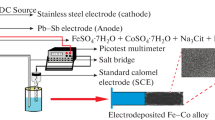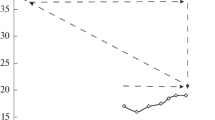Abstract
The electrodeposition of binary Ni–Fe alloys is studied in chloride-based solutions with organic additives. Specific codeposition composition of the electrolyte and operating variables are taken for deposition a wide range of Ni–Fe deposits. Results reveal that in solutions containing sodium citrate and glycolic acid, the nickel content always increases with the current density and nickel concentration. Therefore, nickel reduction rate and the Ni/Fe ratio in the deposits increase. The anomalous codeposition of iron is minimized and the quality of the alloy deposits is improved with the combination of sodium citrate and glycolic acid. Scanning electron micrographs show that, with addition of glycolic acid, the spherical particles become finer and the surface roughness relatively decreases. The XRD patterns of the Ni–Fe deposits exhibit the fcc structure and (111) preferred orientation for alloys with nickel content exceeding 60 wt %. After a heat treatment, additional peaks appear for an Ni–Fe solid solution.
Similar content being viewed by others
REFERENCES
Sasaki, K.Y. and Talbot, K.Y., J. Electrochem. Soc., 1998, vol. 145, p. 981.
Kieling, V.C., Surf. Coat. Technol., 1997, vol. 96, p. 135.
Harris, T.M., Wilson, J.L., and Bleakley, M., J. Electrochem. Soc., 1999, vol. 146, p. 1461.
Leith, S.D., Ramli, S., and Schwartz, D.T., J. Electrochem. Soc., 1999, vol. 146, p. 1431.
Osaka, T., Takai, M., and Tachibana, H., US Patent 6063512, 2000.
Harris, T.M. and Wilson, J.L., US Patent 5932082, 1999.
Biallozor, S. and Lieder, M., Surf. Technol., 1984, vol. 21, p. 1.
Gangasingh, D. and Talbot, J.B., J. Electrochem. Soc., 1991, vol. 138, p. 3605.
Krause, T., Arulnayagam, L., and Pritzker, M., J. Electrochem. Soc., 1997, vol. 144, p. 960.
Horkans, J., J. Electrochem. Soc., 1981, vol. 128, p. 45.
Yin, K.M. and Lin, B.T., Surf. Coat. Technol., 1996, vol. 78, p. 205.
Zech, N., Podlaha, E.J., and Landolt, D., J. Electrochem. Soc., 1999, vol. 146, p. 2886.
Yin, K.M., J. Electrochem. Soc., 1997, vol. 144, p. 1560.
Zech, N., Podlaha, E.J., and Landolt, D., J. Electrochem. Soc., 1999, vol. 146, p. 2892.
Sasiki, K.Y. and Talbot, J.B., J. Electrochem. Soc., 2000, vol. 147, p. 189.
Lieder, M. and Biallozor, S., Surf. Technol., 1985, vol. 26, p. 23.
Srimathi, S.N., Mayarma, S.M., and Sheshadri, B.S., Surf. Technol., 1982, vol. 6, p. 277.
Author information
Authors and Affiliations
Rights and permissions
About this article
Cite this article
Ghorbani, M., Dolati, A.G. & Afshar, A. Electrodeposition of Ni–Fe Alloys in the Presence of Complexing Agents. Russian Journal of Electrochemistry 38, 1173–1177 (2002). https://doi.org/10.1023/A:1021141524584
Issue Date:
DOI: https://doi.org/10.1023/A:1021141524584




